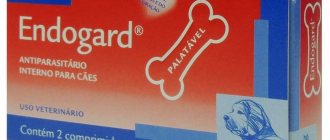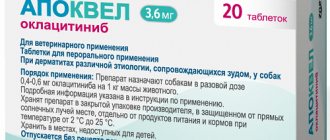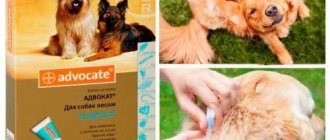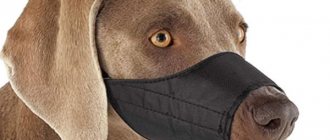Flexoprofen for dogs is a popular pain reliever in veterinary medicine. It relieves pain, swelling and tissue inflammation in a matter of minutes. But it has a number of restrictions on use.
In the review I will consider: the composition and action of Flexoprofen, the features of its use, in what cases the drug is prescribed and possible side effects. At the end of the article I will provide answers to popular questions and recommendations that will help reduce the negative impact of the medication on the gastrointestinal tract.
Our review of the 25 best pain relievers for dogs
How to use the solution correctly
In a veterinary clinic, the solution is administered intravenously; at home, it is used intramuscularly and subcutaneously. The amount of the drug is calculated based on the weight of the pet. There should be 2 mg of medication per 1 kg. The exact dosage is determined by the doctor and depends on the nature of the disease.
Intravenous injection in a cat should be performed in a veterinary clinic.
The therapeutic course ranges from 1 to 5 days. Apply the solution once a day. To administer the medicine subcutaneously, you need to secure your pet by wrapping it in a towel. Then pull back the skin in the withers area, holding it with your thumb and forefinger. Then slowly insert the needle, while the syringe should be located along the spine. If you feel slight resistance, you should not make any effort. The needle must be inserted carefully, immersing it to a depth of 1 cm. Then press the plunger and empty the syringe.
Injecting a cat at the withers is the easiest way to administer an injection.
The injection can also be given intramuscularly. To do this, it is better to use the help of another person who will hold the cat. It is recommended to inject the injection into the thigh muscle at an angle of 90 degrees to the surface. The needle, as in the previous method, should plunge 1 cm. The solution should be injected very slowly.
Injecting a cat in the thigh must be done very carefully.
A friend already has an adult cat who is 10 years old. The pain in the joints began to be so severe that the animal had difficulty moving. The vet recommended NSAID injections. Within a few days, the pet’s condition improved, and after a week he began to move more and forgot about the pain. However, NSAIDs should be used in combination with drugs that restore joint mobility. Otherwise, therapy will give temporary results.
Special instructions and precautions
Important points to note:
- Flexoprofen is not recommended to be combined with other drugs from the NSAID group, as there is a high risk of overdose and adverse reactions.
- For injections, it is better to use insulin syringes.
- There is no need to treat your pet's skin before giving the injection.
- The use of NSAIDs in conjunction with steroid hormones, diuretics, and anticoagulants is prohibited.
- For injections, only a disposable syringe can be used.
- It is recommended to wear gloves before the procedure.
- Under no circumstances should you mix several drugs in one syringe.
For injections, it is best to use an insulin syringe
Features of using the drug for cats
Flexoprofen is widely used in veterinary medicine, including for the treatment of cats. The animal body absorbs the drug well (bioavailability of active substances is 85–99%), side effects rarely occur when used correctly.
Selection of dosage
The dose of the drug depends on the weight of the cat: for every kilogram you need 2 mg of ketoprofen (the active substance, not the medicine). The concentration of the active substance is always indicated on the packaging (for example, if “2.5%” is written on the box and bottle label, this means that 1 ml of the drug contains 25 mg of ketoprofen).
Best articles: What regions is Europe divided into - names, countries and characteristics
Treatment regimen
Flexoprofen injections should be given once a day. The drug is administered subcutaneously, intramuscularly or intravenously. The maximum duration of treatment for cats is 5 days (the duration depends on the goals of therapy - one injection is enough to relieve pain or eliminate fever; when treating joint pathologies, a full course is required).
Flexoprofen is administered subcutaneously, intramuscularly or intravenously
Video: how to give a cat a subcutaneous injection
Treatment of pregnant and lactating cats
Animals bearing cubs are injected with Flexoprofen only in the most extreme cases. The medicine can increase the muscle tone of the uterus and provoke premature labor. In addition, there is a risk that due to the cessation of prostaglandin synthesis, the ductus arteriosus in the fetus will close (which will lead to death or the birth of a kitten with pathologies of the cardiovascular system). A pregnant cat is given the drug only when the expected effect of the drug is more important than the potential threat to the fetus.
Flexoprofen is given to pregnant cats only if failure to treat with this drug is more dangerous than the risk of premature birth.
It is not recommended to inject animals with Flexoprofen before mating, as it reduces the permeability of eggs. The product is also not recommended for nursing cats, since 4–5% of the drug passes into breast milk. Flexoprofen is suitable for treating kittens from the first day of life, but with the most accurate dosage calculation.
Flexoprofen can be administered to kittens, but it is difficult to calculate the dosage yourself, given the small weight of the cub, so it is better to trust this matter to veterinarians
Precautionary measures
Do not allow Flexoprofen solution to get into your eyes. If you get the medicine on your hands, wash it off thoroughly with soap and water (the medicine does not corrode the skin, but you can accidentally rub your eyes, which will cause severe irritation of the mucous membrane).
Vials of Flexoprofen should be kept away from animals and children so that they do not accidentally open the product and drink it. You cannot place the drug in open sunlight or near a heat source - when heated, it loses its properties.
What to do in case of overdose
If a dose exceeding the norm is administered, the cat will experience symptoms of overdose:
- nausea;
- vomit;
- dizziness;
- weakness;
- diarrhea.
With a severe overdose, convulsions begin and blood pressure rises sharply. With such symptoms, the animal needs immediate help. Since there is no antidote for ketoprofen, you have to wait until the effect of the substance wears off (70% is eliminated after 6–7 hours, 80–90% after 24 hours). Until the cat’s body is cleared of the medicine, it must be provided with symptomatic assistance by administering drugs that normalize the functioning of the cardiovascular, respiratory, and digestive systems.
Can I use
Flexoprofen for dogs is an analgesic and anti-inflammatory drug (NSAID) used in dogs to treat pain associated with a variety of disorders.
Prescribed for short-term treatment of animals with soft tissue injuries and other musculoskeletal disorders. In dogs it is used in the complex therapy of osteoarthritis; it can also be used to control:
- high temperature due to bacterial and viral infections;
- postoperative complications;
- fever;
- psychosomatic manifestations after childbirth.
Flexoprofen relieves inflammation by blocking cyclooxygenase enzymes. These enzymes are responsible for the production of prostaglandins. To a lesser extent inhibits lipoxygenases. NSAIDs enhance the effect of bradykinin, which is a chemical remedy for pain and inflammation, and stabilizes lysosome membranes.
During the treatment, the production of prostaglandins and other inflammatory mediators is inhibited, which reduces swelling. The process prevents the release of lysosomes that destroy tissue.
After intramuscular administration, ketoprofen is absorbed very quickly, maximum plasma concentrations are reached after 30-60 minutes. Being a weak acid, it penetrates well into inflamed tissues. Most metabolism occurs in the liver, and metabolites are excreted in the urine.
Different breeds
Flexoprofen is not approved for the symptomatic treatment of chronic musculoskeletal diseases in small animals.
Dog breeds prone to developing dangerous symptoms when treated with NSAIDs:
- Pekingese;
- chihuahua;
- Golden retriever;
- Toy Terrier;
- Bichon Frize.
Do not use to treat breeds with hypersensitivity to ketoprofen or other components of the drug.
Contraindications and side effects
The instructions indicate that Flexoprofen cannot be used to treat dogs in the following cases:
- during pregnancy;
- with liver failure;
- for renal failure and other serious kidney diseases;
- with a stomach or duodenal ulcer;
- with hemorrhagic syndrome.
If the medication is used for animals with chronic diseases of the internal organs, clinical blood and urine tests are regularly performed to help monitor the functioning of the liver and kidneys.
If the recommended doses are followed, the drug rarely causes side effects. To reduce the possible negative impact of the active component on the digestive system and protect the mucous membrane of the stomach and intestines, it is prescribed together with ranitidine or another medicine with a similar effect.
In case of overdose, the following symptoms occur:
- vomit;
- nausea;
- stomach upset.
If they occur, further use of the medicine should be stopped. If you are hypersensitive to the medication, allergic reactions may occur. They can manifest themselves in different ways: itching, redness, rash and other symptoms. In this case, also stop taking the drug. The animal is prescribed anti-allergenic drugs and symptomatic treatment if necessary.
Flexoprofen should not be used for treatment in combination with the following groups of drugs:
- non-steroidal anti-inflammatory drugs;
- diuretics;
- blood thinning medications;
- glucocorticoids.
Important! Do not mix the injection solution with other medications
Pregnant, lactating and puppies
Studies of the effects of ketoprofen during pregnancy on laboratory animals have not revealed any side effects. But during pregnancy and lactation, therapy with this drug is carried out under the supervision of a veterinarian .
Flexoprofen is administered intramuscularly in a minimal dose. It is not recommended for pregnant bitches with an allergy to NSAIDs.
Puppies with impaired liver and blood function are contraindicated in treatment with anti-inflammatory medication.
Indications for use of Flexoprofen
A cat should be treated with Flexoprofen if there are diseases of the musculoskeletal system such as:
- Rheumatoid arthritis;
- Arthrosis;
- Herniated discs;
- Synovitis;
- Degenerative changes;
- Osteochondrosis;
- Fractures;
- Dislocations of limbs;
- Cracks;
- Muscle strains.
It is also permissible to use the drug if the cat exhibits other symptoms of uncertain and definite etiology, including:
- Colic;
- Pain of unknown origin;
- Hyperthermia;
- Swelling.
Giving your cat Flecosprofen is necessary for acute manifestations of these diseases and their chronic inflammation. Unknown causes of pain and increased body temperature in an animal require a mandatory preliminary examination by a doctor.
Instructions for use
According to the instructions, Flexoprofen for dogs is administered intravenously, subcutaneously or intramuscularly once every 24 hours, then they look at the pet’s well-being, how advanced the disease is and, if necessary, extend the course of treatment to five days.
The dosage is prescribed by a veterinarian, but in emergency cases it can be calculated according to the following scheme: 2 mg of ketoprofen per 1 kg of pet’s weight
At the same time, attention is focused on the content of the active unit in the drug by percentage:
- 2.5% - 1 ml contains 25 mg of the main element;
- 5% - 50 mg;
- 10% - 100 mg.
If the pet weighs 25 kg, 50 mg of ketoprofen is used for injection, which is 2 ml of 2.5%; 1 ml of 5% and 0.5 ml of 10% solution.
The doctor also prescribes the regimen for using the drug, and if you approach it irresponsibly and skip the injection, the effectiveness of the treatment will be lower.
Flexoprofen 2.5%, 5% and 10% is prescribed to relieve pain, chills and swelling in combination with the main treatment, because it cannot eliminate the main cause of the disease.
Flexoprofen and analogues (Aynil, Ketoquin, Ketoject, Ketofen) have contraindications for which treatment is unacceptable - pregnancy, liver and kidney failure, bleeding disorders, peptic ulcer of the stomach and duodenum. The drug may cause an allergic reaction, in which case treatment with Flexoprofen is discontinued.
When using the medication in animals with chronic diseases of the internal organs, the pet’s condition is monitored, blood and urine tests are performed, and changes in health are monitored.
With an exact treatment regimen and dosage, side effects appear and occur rarely, but to reduce the negative effect on the gastrointestinal tract, veterinarians prescribe it in combination with Ranitidine (blocks receptors in the gastric mucosa).
If the dosage is incorrect and exceeds the norm, gastrointestinal upset with nausea and vomiting is observed; at the first signs, treatment is stopped.
Individual intolerance to the component and allergic reactions to it are manifested by itching, redness, rash and other similar symptoms. The drug should be stopped and treatment with anti-allergy medications should be started.
The simultaneous use of Flexoprofen and certain types of drugs is not recommended:
- diuretics;
- non-steroidal anti-inflammatory drugs;
- blood thinners;
- glucocorticosteroids.
Do not mix Flexoprofen solution and other drugs, this can cause negative consequences for the animal.
The principle of action of the drug
Ketoprofen effectively eliminates inflammatory processes, relieves pain and reduces body temperature. The active substance disrupts the metabolism of arachidonic acid, inhibiting the synthesis of prostaglandins and thromboxane. It is used to relieve pain during acute, subacute and chronic inflammatory processes in the body.
The drug is administered subcutaneously to cats. And it starts working within 30 minutes. The drug is excreted from the body by the kidneys, mainly through urine.
For what diseases is the medicine effective?
As indicated in the official instructions for use, this medicine is used in the treatment of the following pathologies in cats:
- diseases of the musculoskeletal system, including arthritis and arthrosis;
- to reduce pain in various injuries;
- for acute renal and hepatic colic;
- to relieve pain in the postoperative period;
- for diseases accompanied by increased body temperature.
Flexoprofen effectively eliminates swelling that occurs during injuries and after operations. After the injection, the animal's condition noticeably improves. But the active ingredient of the drug does not affect the speed of recovery. It only makes the general condition easier. Flexoprofen can only be used for cats as prescribed by a doctor.
Dosage regimen
Treatment of cats is carried out by subcutaneous administration of the drug. The dosage is 2 mg per 1 kg of animal body weight.
The solution can be administered intravenously. In this case, treatment should be carried out under the supervision of a doctor. After intravenous injection, the animal needs 24-hour monitoring.
The dosage of the drug is prescribed by the doctor. In case of overdose, the animal may experience the following conditions:
- loss of appetite;
- nausea accompanied by increased salivation;
- vomit;
- stool disorder.
If these signs appear, treatment with Flexoprofen is stopped.
The drug is used strictly on the recommendation of a veterinarian. If you miss another injection, treatment should be resumed as soon as possible and according to the usual regimen. Otherwise, the effect of using the medicine is significantly reduced.
Contraindications
Contraindications to the use of Flexoprofen are:
- pregnancy, regardless of duration;
- feeding offspring;
- renal and liver failure;
- impaired blood clotting ability;
- bleeding;
- stomach ulcer.
The use of the drug should also be avoided if there is an individual intolerance to its components. If the animal shows signs of allergies (rash, itching, dermatitis), the injections are stopped and the cat is given an antihistamine.
special instructions
Flexoprofen should not be used simultaneously with the following drugs:
- other NVPS;
- hormonal agents;
- blood thinning medications;
- diuretics.
The medicine should not be mixed in the same syringe with other drugs.
List of drugs with similar effects
Flexoprofen analogues can only be used with a doctor's permission. The following drugs have a similar effect:
- Ainil (active ingredient ketoprofen) is available in the form of an injection solution;
- Ketoquin (ketoprofen) is available in the form of an injection solution;
- Loxicom (meloxicam) is available in the form of suspensions for oral administration;
- Onsior (robenacoxib) comes in tablet form.
Due to difficulties with dosing, tablets should not be used to treat animals weighing less than 2.5 kg.
Conclusion
Flexoprofen is an effective medicine against pain and fever. It has low toxicity and therefore rarely causes side effects. But to avoid overdose, your pet should be treated only after visiting a veterinarian.
Description of the medicine
This hormonal anti-inflammatory drug belongs to the group of glucocorticosteroids. Its main active ingredient is an analogue of the hormone cortisol - dexamethasone in the form of sodium phosphate and phenylpropionate. In addition, it contains various auxiliary components: sodium chloride and citrate, benzyl alcohol, hydrochloric acid and others. The medicine is a white suspension intended for injection. "Dexafort" is produced in 50 ml bottles. The drug is quite expensive - from 700 to 1000 rubles, and for pets a dose of no more than 2 ml is needed.
Instructions for use
The following methods are used to administer flexoprofen:
- subcutaneously;
- intramuscularly;
- intravenously.
The effectiveness of each method is high, but the choice remains with the attending physician. During complex treatment, the solution cannot be filled into a syringe with other agents; an unexpected chemical reaction may occur.
When calculating the dose of flexoprofen, you should take into account the rate of the active substance per 1 kg of animal weight and the concentration of the solution.
Flexoprofen is not recommended for use in combination with other non-steroidal anti-inflammatory drugs
More often, veterinarians recommend using a 10% composition for treating cats, 1 ml of which contains 100 mg of the active ingredient. The dosage for an animal weighing 5 kg is 0.1 ml.
Flexoprofen is not used to treat cats during pregnancy and lactation.
Rules for using the drug:
- the solution is administered once a day;
- the course of treatment depends on the complexity of the disease, on average up to 5 days;
- Before puncturing the skin with a needle and after the injection, the area is treated with a cotton pad soaked in alcohol (antiseptic standards).
Owner reviews
Denis: “I used it for my dog several times. I always gave two, maximum three injections. Never used it for a long time. Easy to dose: on the vet’s advice, I divided the daily dose and administered it twice a day. Side effects arose, but quickly passed after discontinuation and dietary nutrition.”
Julia: “My joyful miniature pinscher Nora became very ill on the eve of the weekend: she refused to eat, vomited, and lay in bed. In addition, her temperature rose to 40.5°C, she had convulsions, and her hind legs and tail were tense. While we were waiting for everyday life to conduct an examination and find out the reason, I decided to give Flexoprofen injections. After the first injection, the dog ate and came to life a little. The temperature dropped and the tension in the limbs went away. The drug relieved the pain and helped the pet survive until a visit to the hospital. Although, as tests later revealed, the liver was slightly damaged.”
Directions for use and dosage
Flexoprofen 2.5%, 5% and 10% is administered parenterally or intramuscularly to four-legged friends once every 24 hours. Injections are repeated for a maximum of 5 days. The dosage of Flexoprofen for dogs and cats is calculated according to a special program and is administered subcutaneously, intramuscularly or intravenously at the rate of 2 mg/kg of the beloved pet’s weight.
Read the instructions and rules for taking medications for dogs such as: “Amit”, “Surolan”, “Roncoleukin”, “Ivermectin”, “Tsiprovet”, “Propalin”, “Katozal”, “Ivermec”, “Tylosin”, “ Milbemax" and "Vetom 1.1". Before using these medications, be sure to consult your veterinarian.
- In case of an overdose, patients may have a lack of appetite, loose stools, or frequent regurgitation. If such symptoms occur, medication injections should be interrupted.
- No special reactions of the body of domestic animals to the solution during the initial administration or upon cessation of injections were recorded.
- You should not skip the subsequent dose of flexoprofen, as there is a risk of reducing the effectiveness of therapy. If an injection is missed, medication consumption is started again in the same dosage in accordance with the regimen.
Safety precautions and hygiene rules
An important point when injecting Flexoprofen is strict adherence to the rules of personal hygiene and safety precautions that are indicated when working with any medications. At the time of injection, you should not drink alcohol, smoke, or eat. Upon completion of healing, you must thoroughly wash your hands with soapy water and rinse with plenty of water. If the medication gets on the skin or mucous membranes of the eyes, you need to clean the contact surface with a strong stream of running water.
People with hypersensitivity to the components of Flexoprofen should avoid direct contact of the analgesic with the above areas of the body. If allergy symptoms occur, as well as if the medicine inadvertently enters the human body, you should immediately visit the nearest hospital (it is better to take the instructions or packaging of the medicine with you).
When not to use
According to the instructions, Flexoprofen for cats cannot be used in the following cases:
- when bearing offspring (regardless of the period);
- with liver failure;
- with renal failure;
- for problems with blood clotting;
- with bleeding;
- with stomach or duodenal ulcers.
You should also avoid using the drug if you are intolerant to the active substance or other components. For chronic pathologies of the liver and kidneys, it is necessary to consult a doctor before use. In this case, it is recommended to constantly monitor the performance of these organs.
The anesthetic is usually well tolerated by animals and does not cause side effects. In case of intolerance to the components, allergic reactions occur. In this case, further treatment with an anti-inflammatory drug is stopped and anti-allergy medications and drugs are prescribed to relieve the symptoms that appear.
In case of overdose, the following side effects may occur:
- nausea;
- vomit;
- stomach upset;
- loss of appetite;
- refusal of food;
- weakness.
If such symptoms appear, stop taking Flexoprofen. If the animal's condition does not improve, you should consult a doctor.
Precautionary measures
When prescribing injections, standard safety precautions for contact with veterinary solutions are observed. When using the drug, you must wear rubber gloves to avoid direct contact with the drug. If the product gets into your eyes or hands, rinse immediately with plenty of water, and if an allergic reaction occurs, seek medical help. Empty medication containers must be disposed of.
After the procedure, you must carefully monitor the condition of the animal and at the first questionable symptoms, contact a veterinarian.
With the right approach and comprehensive treatment, the animal will feel better, but it should be remembered that unauthorized prescription of drugs can be disastrous for the pet, so all procedures must be coordinated with a veterinarian.
Pharmacological properties of the drug
The active component of the drug, as we have already mentioned, is ketaprofen. It has the following properties:
- Antipyretic.
- Anti-inflammatory.
- Painkiller.
According to the instructions and reviews of Flexoprofen for cats, the drug is successfully used to treat a whole range of inflammations - acute, chronic, subacute, accompanied by pain. The mechanism of action of ketaprofen is as follows: the substance disrupts metabolic processes with arachidonic acid, which in turn suppresses the formation of prostaglandins.
With intramuscular administration of the drug, its highest concentration in the blood plasma is noticeable within half an hour. Bioavailability for the body: 85-100% (depending on the type of animal). The medicine is excreted through the kidneys.
The instructions for Flexoprofen for cats indicate that the product is close to low-hazard (class 4 according to GOST 12.1.007-76). If the recommended dosage is followed, it does not have a sensitizing effect on the patient’s body.
Directions for use and doses
The dosage for each individual must be determined by a veterinarian; depending on the weight of the animal and its physique, the injection site and dose vary.
Pigs
Pigs are given an injection into the muscle at a rate of 3 mg/kg body weight, one dose per day, duration - from five days to a week.
Find out everything about breeding pig breeds such as Landrace, Karmaly, Pietrain, Hungarian downy Mangalitsa, Vietnamese, Duroc, Mirgorod, Red-belted.
Dogs and cats
"Flexoprofen" for cats and dogs, the dosage is 2 mg/kg, once a day, course from one to five days. The drug is injected into a vein or muscle.
Did you know? In the USA there is a church whose parishioners are dogs. The artist Stefan Hanek, who built the church, thanked his Labradors in such an unusual way for helping him overcome a serious illness.
Medicinal properties
The main active ingredient ketoprofen is a secondary product of propionic acid, which belongs to the group of carboxylic acids, has therapeutic properties when affecting inflammation, pain and high temperature, therefore it is prescribed for the treatment of chronic diseases or those in an acute stage that cause attacks of severe pain.
Ketoprofen suppresses the synthesis of prostaglandins and thromboxane due to disruption of arachidonic acid metabolism. An intramuscular injection of ketoprofen allows one to achieve a macroconcentration of the analgesic in the blood plasma of patients half an hour after the injection. The ability of the drug to be absorbed in a living organism (bioavailability) ranges from 85 to 100% (it all depends on which animal the analgesic is administered). The body eliminates the substance through the kidneys.
Shelf life and storage conditions
"Flexoprofen" must be stored in a closed cardboard box from the manufacturer, in a dry, dark place, avoiding contact with direct sunlight. You should not keep food or food for your beloved pet near the drug. Favorable temperature conditions are +5…+25 °C. At a temperature of about +5 ° C, ketoprofen, the main component of the drug, crystallizes during long-term storage. However, as soon as the degrees begin to increase, the ketoprofen crystals dissolve, while the quality of the solution remains unchanged.
If you adhere to the specified storage rules, the shelf life of Flexoprofen is 3 years from the date of manufacture. Do not use expired medication under any circumstances.
Flexoprofen should be well hidden from children. Unused glass solution jars are disposed of in accordance with legal regulations.
Do not resort to self-medication under any circumstances. If symptoms of an inflammatory process appear, low-grade fever, fever and other ailments of our smaller four-legged brothers appear, the best help would be an immediate visit to the veterinarian. The drug "Flexoprofen" does not treat the cause, but only fights the consequences of the disease.
Answers to frequently asked questions
Have crystals appeared in the solution? Is the medicine spoiled?
No, this is normal. Occurs when the drug is stored in the refrigerator, at a temperature of about 5°C. The crystals do not affect the quality of the drug and will disappear if the solution is warmed.
Can Flexoprofen be given to pregnant dogs?
The instructions prohibit giving injections to pregnant and lactating bitches due to the risk to puppies. But in conditions that threaten the dog’s life, the solution is administered under the supervision of a veterinarian.
Is the medication suitable for all breeds?
It has been noted that side effects develop more often in small dogs. The following breeds are more prone to them: Chihuahua, Bichon Frize, Pekingese, Toy Terrier.
The dog vomited after the injection. Is it worth continuing to give the drug?
If any negative reactions occur, NSAIDs are discontinued. But each case is individual: consult your veterinarian. It is possible that gastro- and hepatoprotectors will be additionally prescribed.
Flexoprofen
FLEXOPROFEN for the treatment of inflammatory diseases of the musculoskeletal system and as an analgesic and antipyretic agent in dogs, cats, racing horses and calves
(organization-, Republic of Belarus)
I. GENERAL INFORMATION
Flexoprofen 2.5%, 5% and 10% (Flexoprofen 2.5%, 5%, 10%) is a non-steroidal anti-inflammatory drug in the form of an injection solution used for the treatment of inflammatory diseases of the musculoskeletal system and as an analgesic and antipyretic products for dogs, cats, sports horses and calves and containing in 1 ml 25, 50 and 100 mg of ketoprofen as an active substance, respectively, and L-arginine, benzyl alcohol, citric acid and water for injection as excipients.
Flexoprofen is a colorless or slightly yellow transparent solution.
Flexoprofen 2.5%, 5% and 10% are packaged in 5, 10, 20, 30, 50, 100, 200 and 250 ml in dark glass bottles of appropriate capacity. Each bottle is labeled in Russian indicating: the manufacturing organization, its address and trademark, the name of the drug, the name and content of the active substance, the amount of the drug in the bottle, the batch number (containing the date of manufacture), the expiration date, storage conditions, the inscriptions “ Sterile”, “For injection”, “For animals” and provide instructions for use
Flexoprofen is stored with caution (list B) in a dry place, protected from direct sunlight at a temperature of 5 C to 25 C. Shelf life under storage conditions is 3 years from the date of manufacture
Flexoprofen should not be used after the expiration date.
II. PHARMACOLOGICAL PROPERTIES
Ketoprofen, which is part of Flexoprofen, has anti-inflammatory, analgesic and antipyretic effects, and is effective for the treatment of acute, subacute and chronic inflammation, accompanied by the symptom of pain. The mechanism of action of ketoprofen is to suppress the synthesis of prostaglandins by disrupting the metabolism of arachidonic acid. With intramuscular administration of the drug, the maximum concentration of ketoprofen in the blood plasma is observed after 30 minutes. The bioavailability of ketoprofen, depending on the type of animal, varies from 85% to 100%. Ketoprofen is excreted from the body primarily through the kidneys.
In terms of the degree of impact on the body, according to GOST 12.1.007-76, Flexoprofen belongs to hazard class 4 (low-hazard substances); in recommended doses does not have a sensitizing effect in the body.
III. ORDER OF APPLICATION
Flexoprofen is used to treat inflammatory diseases of the musculoskeletal system (arthritis, arthrosis, dislocations, edema, herniated discs, synovitis, tenosynovitis, etc.), pain syndrome of various etiologies (traumatic and postoperative pain, colic), as well as hyperthermia in dogs, cats, sport horses and calves.
Directions for use and dosage:
Dogs, cats: subcutaneously, intramuscularly, intravenously at a dose of 2 mg/kg of animal weight (according to ketoprofen), 1 time per day, for 1-5 days.
Sports horses: intravenously at a dose of 2.2 mg/kg of animal weight (according to ketoprofen), 1 time per day, for 1-5 days.
Calves: intravenously or intramuscularly at a dose of 3 mg/kg of animal weight (according to ketoprofen), 1 time per day, for 1-5 days.
In recommended doses, Flexoprofen does not cause complications in animals.
Contraindications to the use of Flexoprofen are allergies to ketoprofen and other components of the drug, stomach and duodenal ulcers, hemorrhagic syndrome, severe liver and kidney failure, pregnancy. Flexoprofen is not recommended for use in combination with other non-steroidal anti-inflammatory drugs, glucocorticoids, anticoagulants and diuretics. Do not mix with other medications in the same syringe.
Slaughter of calves for meat is permitted no earlier than 5 days after the last use of the drug. The meat of forcedly killed animals before the expiration of the specified period can be used as feed for fur-bearing animals or for the production of meat and bone meal.
IV. PERSONAL PREVENTION MEASURES
When working with Flexoprofen 2.5%, 5% and 10%, you should follow the general rules of personal hygiene and safety precautions provided for when working with medicines.
Containers containing the drug are prohibited from being used for household purposes.
Flexoprofen should be stored out of the reach of children. Registration number PVI-2-1.8/02383
www.vetlek.ru
Release form and composition
Flexoprofen is a veterinary non-steroidal anti-inflammatory drug (NSAID). It is produced by Russian. It has branches in Belarus and Kazakhstan, plus supplies products to European countries.
Available in 3 dosages. Each contains different contents of active substances:
| Dosage | Content of active ingredients (mg per 1 ml) | |
| Ketoprofen | L-arginine | |
| 2,5% | 25 | 18 |
| 5% | 50 | 36 |
| 10% | 100 | 72 |
The first two dosages of Flexoprofen are intended for dogs and other small pets. And the last one is for horses, pigs and cattle.
Additionally, the drug contains excipients: gasoline alcohol (0.01 g), citric acid (pH 6–7), water for injection up to 1 ml.
Externally, Flexoprofen is a colorless solution. Light yellow sediment is allowed. NSAIDs are packaged in vials of different sizes. The most popular forms:
- 10 ml bottle, dosage 2.5%. On average it costs 345 rubles.
- 50 ml bottle, 5% dosage. They sell for 620 rubles.
Price and analogues
The cost of the medicine differs depending on the concentration of the solution and the capacity of the bottle:
- volume 10 ml 2.5% - 297 rubles;
- volume 50 ml 5% - 543 rub.
Flexoprofen is an effective remedy, but if it is not possible to use it to treat your pet, then you should, together with your veterinarian, select another drug that has a similar pharmacological effect. Recommended analogues:
- Ainil;
- Ketofen;
- Ketoject;
- Ketoquin.
An analogue of ketofen is a non-steroidal anti-inflammatory drug.
If, after administration of the medicine, the pet develops symptoms characteristic of an allergy, further use should be discontinued.
It is strictly prohibited to make changes to therapy on your own.
How much does it cost and where to buy?
The price of Flexoprofen depends on the concentration and volume of the package. A 10 ml bottle with a 2.5% solution costs about 300 rubles, and a 50 mm container with a 5% liquid will cost 670 rubles. Usually the weakest solution is purchased for dogs. You can make a purchase at a regular veterinary pharmacy or online. Since the medicine is produced by a Moscow company, there is usually no shortage of it.
You can now view the current price of the drug and buy it right here:
Price and analogues
The cost of the medicine depends on the volume; the price of a 10 ml bottle is 320 rubles. A 50 ml bottle can be purchased for 720-850 rubles. You can buy Flexoprofen not only in clinics or veterinary pharmacies, but also on the Internet.
Pharmacies offer various analogues of the drug, which have a common active substance - ketoprofen. List of similar compositions for dog therapy:
- Ketofen. The medication is available in the form of a ready-made solution for injection. Well tolerated, but at the beginning of treatment it can cause gastrointestinal disorders. Approved for pregnant and lactating women. Price – 730 rub.
- Ainil is a colorless homogeneous solution for injections. It has a similar effect to Flexoprofen, relieves swelling and relieves pain. However, it can cause dangerous pathologies in the fetus and is not recommended for the treatment of pregnant dogs. Cost – 890 rub. per package.
- Ketoquin is a domestic medicine that has restrictions on the age and weight of pets. Should not be used in the treatment of dogs with gastric ulcers. The market price is 360 rubles.
Only a veterinarian can replace a veterinary drug with a similar one.
Ketoprofen is used to treat moderate pain and inflammation. In most animals it has a half-life of less than 2 hours and a duration of action of up to 24 hours.
Flexoprofen may interact with other substances contained in medications. Concomitant use with aspirin, corticosteroids and anticoagulants is contraindicated.
Table of drugs similar in effect
| Name | Release form | Active ingredient | Indications | Contraindications | Adverse reactions | Can it be used to treat pregnant and lactating cats? | Price |
| Vetalgin | Pills |
| Inflammatory and infectious diseases, as well as spasms of smooth muscles. |
| Allergic reactions. | No. | From 134 rub. |
| Diclofenac |
| diclofenac sodium |
|
|
| No. | From 100 rub. |
| Ketoprofen |
| ketoprofen |
|
|
| No. | From 140 rub. |
special instructions
Special conditions for using this drug are as follows:
When administering an injection to an animal, it is important to follow personal hygiene instructions and safety precautions for working with medications. Eating food, liquids, and smoking are strictly prohibited during this time! At the end of the procedure, be sure to wash your hands with soap. If the solution gets on your skin or mucous membranes, wash them with plenty of water.
If strange reactions occur, especially if you are hypersensitive to at least one of the components of the drug, you should contact a medical facility as soon as possible. Do not use bottles of the product for household purposes. Do not allow children to have access to the medicine.
"Flexoprofen", which also has more expensive analogues, is an excellent remedy with few contraindications, and has little danger in case of overdose. And, as we have seen, it has a wide range of indications for use, suitable not only for cats and dogs, but also for a number of other animals.
Important points
When using Flexoprofen to treat cats, the following should be considered:
- The anesthetic should not be combined with the use of other non-steroidal anti-inflammatory drugs to avoid overdose.
- It is not recommended to use the medicine together with anticoagulants (drugs that thin the blood), glucocorticoids and laxatives.
- Do not mix an anti-inflammatory drug with other medications in the same syringe.
- When administering a medicinal solution, you must follow the rules of antiseptics. For injections, use disposable syringes or sterile needles that have been boiled for 15 minutes.
Flexoprofen can have a negative effect on the digestive system and cause bleeding, so its use is often combined with Ranitidine or other similar medications.
When working with the drug, you need to follow simple safety precautions. After the procedure, wash your hands with soap and running water. Medicine bottles must be disposed of; using them for domestic purposes is strictly prohibited. If you are hypersensitive, you should use rubber or latex gloves to avoid direct contact with the solution, which can cause a rash or other allergic reactions.
Flexoprofen 10
Flexoprofen 10% - (ketoprofen) treatment of inflammatory diseases of the musculoskeletal system (arthritis, arthrosis, dislocations, edema, synovitis, tenosynovitis, etc.), pain syndrome of various etiologies. Indications for use Treatment of inflammatory diseases of the musculoskeletal system (arthritis, arthrosis, dislocations, edema, synovitis, tenosynovitis, etc.), pain syndrome of various etiologies (traumatic and postoperative pain, colic), as well as hyperthermia in cattle, pigs, horses, dogs and cats. Advantages • high stability and security; • shelf life is 1.5 times higher than analogues; • maximum concentration in blood plasma is achieved after 30 minutes; • the possibility of using the antibacterial drug TIOCEFUR as a solvent. Composition and release form FLEXOPROFEN 10% injection solution contains 100 mg of ketoprofen as an active ingredient in 1 ml. FLEXOPROFEN 10% is produced in the form of a sterile, transparent, colorless or slightly yellowish solution in glass or plastic bottles of 1; 2; 5; 10; 20; thirty; 50; 100; 200; 250; 500 and 1000 ml. Pharmacological properties Ketoprofen, which is part of FLEXOPROFEN, has anti-inflammatory, analgesic and antipyretic effects, is effective for the treatment of acute, subacute and chronic inflammation, accompanied by the symptom of pain. The mechanism of action of the drug is to suppress the synthesis of prostaglandins by disrupting the metabolism of arachidonic acid. When administered intramuscularly, the maximum concentration of ketoprofen in the blood plasma is observed after 30 minutes. The bioavailability of the drug varies from 85% to 100%. Ketoprofen is excreted from the body primarily through the kidneys. In recommended doses, the drug does not have a sensitizing effect and does not accumulate in the body. Dosage regimen • cattle: intravenously or intramuscularly at a dose of 3 mg/kg of animal weight (according to ketoprofen), 1 time per day, for 1-5 days; • pigs: intramuscularly at a dose of 3 mg/kg of animal weight (according to ketoprofen), 1 time per day for 1-3 days; • horses: intravenously at a dose of 2.2 mg/kg of animal weight (according to ketoprofen), 1 time per day, for 1-5 days; • dogs, cats: subcutaneously, intramuscularly, intravenously at a dose of 2 mg/kg of animal weight (according to ketoprofen), 1 time per day, for 1-5 days. Contraindications Contraindications to the use of Flexoprofen are individual hypersensitivity to ketoprofen and other components of the drug, stomach and duodenal ulcers, hemorrhagic syndrome, severe liver and kidney failure, pregnancy. Special instructions FLEXOPROFEN is not recommended for use in combination with other non-steroidal anti-inflammatory drugs, glucocortioids and anticoagulants. Do not mix with other medications in the same syringe. Slaughter of animals for meat is permitted no earlier than 5 days after the last use of the drug. Meat of forcedly killed animals before the expiration of the specified period can be used for animal feeding or for the production of meat and bone meal
Conditions and periods of storage Store FLEXOPROFEN with precautions (list B) in a dry place, protected from light, at a temperature not exceeding 25 ° C. Shelf life, subject to storage conditions, is 3 years from the date of manufacture.
General characteristics of the drug
The Russian pharmaceutical company produces Flexoprofen for dogs, cats, cattle, pigs and sports horses. The medicine is a pale yellow or colorless transparent solution with a specific odor. The liquid is packaged in 5-250 ml bottles made of dark glass, sealed with rubber stoppers and aluminum caps. The medicine goes on sale in cardboard packs. In each of them, the manufacturer places 1, 6 or 10 bottles of solution and detailed instructions for use.
The cost of the drug depends on the concentration of the active component (2, 5 or 10%) and the volume of the drug in the package. Thus, a 10-ml container with a 2.5% solution can be purchased for 290–320 rubles. The price of a bottle containing 50 ml of Flexoprofen (5%) can reach 700 rubles.
The medicine must be stored in its original packaging away from feed and food products.
It is important to ensure that the bottle with the solution is reliably protected from sunlight and moisture. Storage temperature should not fall below 5 °C and rise above 25 °C
After the expiration date (36 months from the date of issue), any remaining Flexoprofen must be disposed of.











